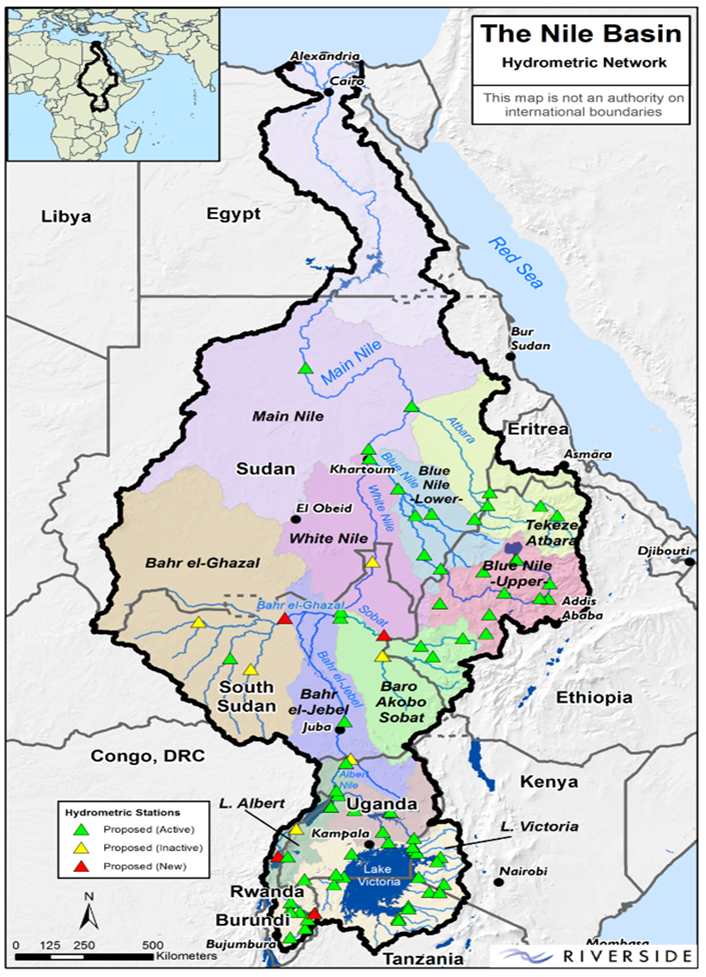
The NBI developed a Nile River Basin Monitoring Strategy (2010) to guide its activities for enhancing the monitoring system in the basin, and therefore to provide the data required to facilitate the implementation of various projects and programmes. Within the context of operationalisation of the Nile Basin Monitoring Strategy, the Nile Basin Hydro-meteorological System detailed design specifications as well as implementation plans were prepared in 2015.
With financing from BMZ-EU, the NBI is currently undertaking the implementation of the first phase of the HydroMet system focusing on hydrological monitoring networks as per the approved design and implementation plan by the Nile Council of Ministers in its 23rd meeting on June 4, 2015, in Dodoma, Tanzania.
The NBI is supporting the Member States in establishing and operationalising a regional hydrological monitoring system to provide more reliable data and information for water resources management. With increasing availability of credible and continuously observed data, the countries will be able to improve the water resources planning and management, as well as utilise their water resources more efficiently both at regional and national levels; be better prepared against natural hazards, such as floods and droughts; monitor changes in the Nile Basin climate and, hence, improve their climate change adaptation plans, among others.
Therefore, the nine Member States (Burundi, DR Congo, Ethiopia, Kenya, Rwanda, South Sudan, Sudan, Tanzania and Uganda) are benefiting from the HydroMet project activities organised around the following main components: (i) Rehabilitation/construction of selected stations prior to installation of equipment, (ii) procurement and installation of new equipment at stations, (iii) upgrading national and regional data centres through acquisition of data management system hardware and software, (iv) capacity building for national staff to support the hydrometric system installation and operation, and (v) information products to be generated from real data collected at regional stations to support decision making in water resources management.
The NBI HydroMet task team is coordinating the overall implementation of the project activities in collaboration with the national teams from the National Hydrological Services in Member States to ensure the sustainability as the owners of the stations. An international Consulting firm was contracted to technically support the implementation at different project phase and a contractor has been selected in each country to carry out civil works at stations prior to installation of equipment.
A regional hydrological monitoring network of 60 hydrological stations established for better monitoring of the Nile’s water resources.
The data will be transmitted from regional stations to the national data processing centres using tworedundant data transmission methods (Satellite and GPRS) as shown below so that highest reliability can beachieved.
These Data Management System equipments shall be used for generating the information products from the regional hydrological monitoring network.
The Nile Basin regional hydrological monitoring system has been designed within the context of operationalisation of the Nile Basin Monitoring Strategy developed in 2010.
The HydroMet System design specifications and implementation plan were approved by the Nile Council of Ministers in its 23rd meeting on June 4, 2015, in Dodoma, Tanzania, as priority project for implementation.
The statement of purpose given for the NB HydroMet system (Nile-COM): “We Member States of the Nile Basin Initiative are united and dedicated to establish and share an ever-growing understanding of the water resources of the Nile Basin and to engage that understanding in wise stewardship and sustainable socio-economic development”.
The following activities have been accomplished:
Updating the hydroMet system design through country consultations undertaken in Member States for baseline update of the national hydrological systems.Sites needs assessment undertaken at stations in Member States with the objective of identifying necessary upgrades ...
Accomplished Activities
- Updating the hydroMet system design through country consultations undertaken in Member States for baseline update of the national hydrological systems.
- Sites needs assessment undertaken at stations in Member States with the objective of identifying necessary upgrades with respect to civil works and hydrological monitoring equipment.
- Inception workshop in Khartoum on February 18-19, 2020, to provide an update on the status of the project and to present key design elements for discussion and consensus; including sustainability and data management issues.
- Nile-TAC HydroMet design validation steering meeting held on May 5, 2021 in Addis Ababa to review and approve the final regional hydrological monitoring network design in view of the trans-boundary significance and other related considerations, a regional network of 60 stations was validated (Final system design Report was produced).
- Procurement of HydroMet equipment is completed, NBI contracted OTT HYDROMET Corporate to supply equipment to nine Member States.
- NBI contracted civil works contractor in each country for rehabilitation of the stations prior to installation of new equipment.
- Procurement of data management system hardware and software is completed; the information products will be generated using this equipment.
- Environment and Social Management Plan (ESMP) has been developed to manage the environmental and social impacts associated with HydroMet civil works implementation at stations.
- Civil works constructions implementation in member countries.

